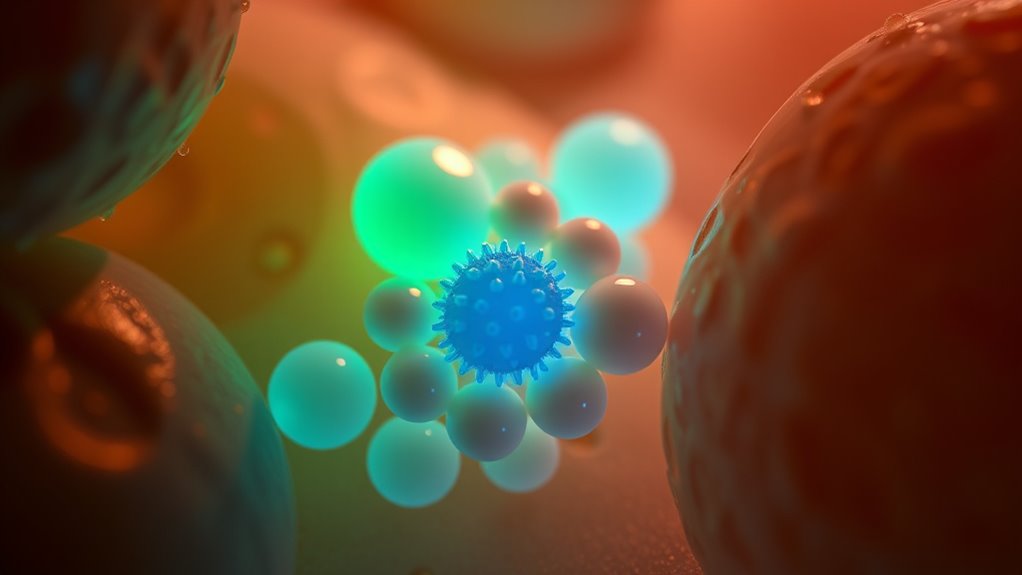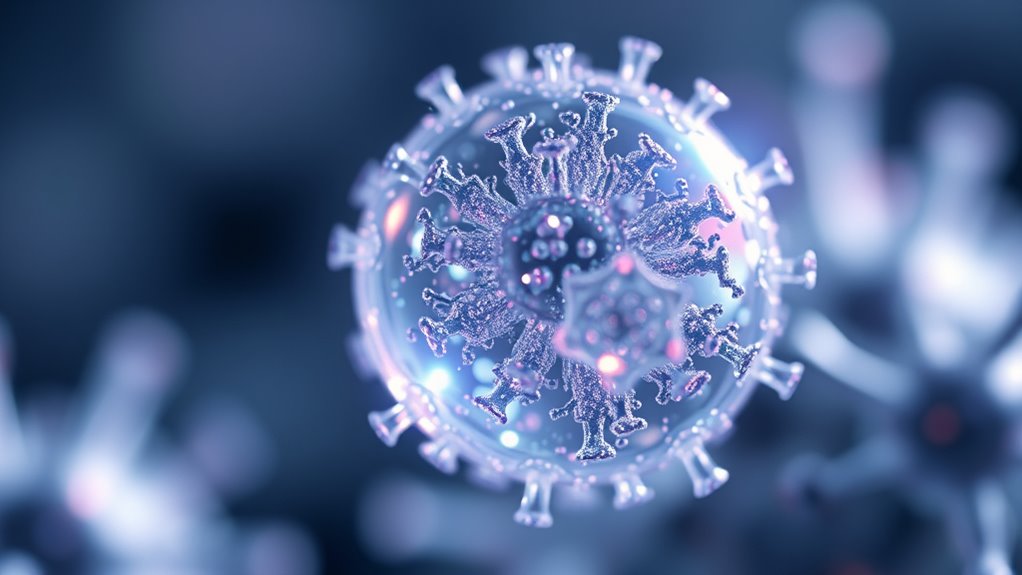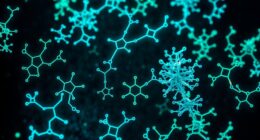Nanomedicine involves shrinking drug delivery systems to the size of viruses, allowing you to target specific cells with incredible precision. These tiny particles, called nanoparticles, can recognize disease markers and deliver drugs directly where needed, minimizing side effects and reducing damage to healthy tissues. They also protect drugs and control their release, making treatments more effective. If you’re curious about how this cutting-edge technology transforms medicine, there’s much more to discover.
Key Takeaways
- Nanomedicine involves designing nanoparticles comparable in size to viruses for targeted drug delivery.
- These nanoparticles can recognize disease markers and navigate directly to infected or cancerous cells.
- Shrinking drug carriers to virus size enables precise attachment and controlled release at the disease site.
- Nanoparticles protect drugs from degradation and improve solubility, enhancing treatment effectiveness.
- Such nanoscale systems allow for minimally invasive, highly targeted therapies with fewer side effects.

Have you ever wondered how tiny particles can revolutionize medicine? The answer lies in nanomedicine, a field that manipulates particles at an incredibly small scale—so small that they’re comparable to viruses. These nanostructures open up new possibilities for targeted therapy and drug delivery, making treatments more effective and less invasive.
Instead of relying on traditional methods that often affect the entire body and cause side effects, nanomedicine allows you to deliver drugs directly to specific cells or tissues, increasing precision and reducing harm.
Nanomedicine targets drugs precisely, reducing side effects and increasing treatment effectiveness.
Targeted therapy is one of the most exciting aspects of nanomedicine. Imagine a tiny vehicle that can navigate through your bloodstream and find only the cancer cells, leaving healthy cells untouched. This is possible because nanoparticles can be engineered to recognize certain markers on diseased cells.
Once they locate the target, they release their therapeutic payload directly where it’s needed most. This precision minimizes side effects and enhances treatment efficacy. Nanoparticles can be designed with surface molecules that act like GPS signals, guiding them to their intended destination. This level of accuracy isn’t achievable with conventional drugs, which often spread throughout the body, affecting both healthy and diseased tissues.
Drug encapsulation is another key feature that makes nanomedicine so promising. Instead of administering a drug in its raw form, which can degrade quickly or cause unwanted reactions, nanoparticles act as protective carriers. They encapsulate the drug molecules within their structure, shielding them from the body’s defenses and controlling the release rate.
This means you get a sustained, targeted dose over time, reducing the need for frequent administrations and improving patient compliance. Encapsulation also prevents premature drug breakdown, ensuring the medication remains effective until it reaches its target.
*Furthermore*, encapsulating drugs in nanoparticles can improve solubility for those medications that are poorly water-soluble, broadening the range of drugs that can be used effectively. Advances in nanotechnology are enabling the development of multifunctional nanoparticles capable of simultaneously diagnosing and treating diseases, a concept known as theranostics. Additionally, understanding systematic delivery methods enhances the precision of nanomedicine applications.
Frequently Asked Questions
How Long Does It Take to Develop New Nanomedicine Therapies?
Developing new nanomedicine therapies can take several years, depending on clinical trial timelines and regulatory approval processes. You’ll start with lab research, then move through preclinical studies, clinical trials, and finally, approval from authorities like the FDA.
Each stage varies in length, often taking 5 to 10 years or more. Patience and careful navigation of these steps are vital to bring safe, effective nanomedicine therapies to patients.
What Are the Biggest Safety Concerns With Nanomedicine?
You should consider that safety concerns with nanomedicine include nanoparticle toxicity, which might harm cells or cause unforeseen side effects.
Environmental impact is also a significant concern, as these particles could accumulate in ecosystems.
These risks require thorough testing before widespread use.
While nanomedicine offers exciting potential, addressing nanoparticle toxicity and environmental impact is vital to guarantee safe, responsible development and avoid long-term health or ecological issues.
How Cost-Effective Are Nanomedicine Treatments Compared to Traditional Ones?
When considering nanomedicine treatments, you’ll find that cost comparison often shows higher initial expenses compared to traditional methods.
However, an affordability analysis reveals potential long-term savings due to targeted delivery, reduced side effects, and faster recovery times.
While the upfront costs may be steep, the improved effectiveness and decreased need for additional treatments can make nanomedicine a cost-effective option overall.
Can Nanomedicine Be Used for Non-Cancerous Diseases?
Did you know that over 80% of nanomedicine research focuses on cancer?
But nanomedicine isn’t limited to cancer treatments; it’s also used for non-cancerous diseases like cardiovascular, neurological, and infectious conditions.
With targeted delivery, nanomedicine can precisely reach affected areas, reducing side effects.
It also plays an essential role in regenerative medicine, promoting tissue repair and healing.
What Are the Challenges in Scaling up Nanomedicine Production?
When you consider scaling up nanomedicine production, manufacturing scalability becomes a major challenge because small laboratory methods often don’t translate easily to large-scale processes.
You also need strict quality assurance to guarantee consistency and safety across batches.
Balancing these factors is essential, as increased production demands careful control, reliable quality checks, and adherence to regulations, all of which can complicate efforts to bring nanomedicine therapies to broader clinical use.
Conclusion
Imagine stepping into a tiny universe where your medicine becomes a brave explorer, charting the vast landscape of your body like a virus. With nanomedicine, you hold the power to transform this journey—making treatments more precise and effective. Like a dedicated messenger on a mission, these nanocarriers deliver hope directly to where it’s needed most. Embrace this revolution, and watch as healthcare shrinks to fit the size of miracles.









